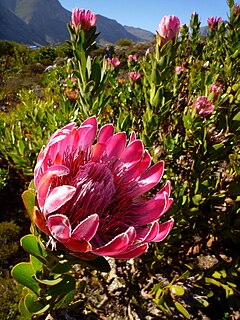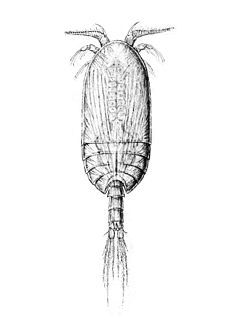
The substantia nigra (SN) is a basal ganglia structure located in the midbrain that plays an important role in reward and movement. Substantia nigra is Latin for "black substance", reflecting the fact that parts of the substantia nigra appear darker than neighboring areas due to high levels of neuromelanin in dopaminergic neurons. Parkinson's disease is characterized by the loss of dopaminergic neurons in the substantia nigra pars compacta.

Yareta or llareta is a flowering plant in the family Apiaceae native to South America. It grows in the Puna grasslands of the Andes in Peru, Bolivia, northern Chile, and western Argentina at altitudes between 3,200 and 5,250 metres.

Berberis, commonly known as barberry, is a large genus of deciduous and evergreen shrubs from 1–5 m (3.3–16.4 ft) tall, found throughout temperate and subtropical regions of the world. Species diversity is greatest in South America and Asia; Europe, Africa and North America have native species as well. The best-known Berberis species is the European barberry, Berberis vulgaris, which is common in Europe, North Africa, the Middle East, and central Asia, and has been widely introduced in North America. Many of the species have spines on the shoots and all along the margins of the leaves.

Pterobranchia is a clade of small worm-shaped animals. They belong to the Hemichordata, and live in secreted tubes on the ocean floor. Pterobranchia feed by filtering plankton out of the water with the help of cilia attached to tentacles. There are about 25 known living pterobranch species in three genera, which are Rhabdopleura, Cephalodiscus, and Atubaria. On the other hand, there are several hundred extinct genera, some of which date from the Cambrian Period.

Andromeda polifolia, common name bog-rosemary, is a species of flowering plant in the heath family Ericaceae, native to northern parts of the Northern Hemisphere. It is the only member of the genus Andromeda, and is only found in bogs in cold peat-accumulating areas.
The pars compacta is a portion of the substantia nigra, located in the midbrain. It is formed by dopaminergic neurons and located medial to pars reticulata. Parkinson's disease is characterized by the death of dopaminergic neurons in this region.

Protea compacta is similar to Protea eximia. Its distribution is from the Kleinmond to Bredasdorp Mountains and is one of the best known proteas in the cut flower industry. Its leaves curve upward.

Eurybia compacta, commonly known as the slender aster, is an herbaceous perennial native to the eastern United States from New Jersey to Georgia. It is commonly found along the coastal plain in dry sandy soils, especially in pinelands. While it is not considered to be in high danger of extinction, it is of conservation concern and has most likely been extirpated from much of its original range. The slender aster was for a long time considered to be a variety of E. surculosa, but Guy Nesom's recent research within the genus has shown that it is distinct enough to be treated as a species. It has also been shown to be related to E. avita and E. paludosa.
Cochliopina is a genus of very small freshwater snails that have an operculum, aquatic gastropod mollusks in the family Hydrobiidae, the mud snails.

The oblong rocksnail is a species of freshwater snail with an operculum, an aquatic gastropod mollusk in the family Pleuroceridae.
Victaphanta compacta, common name the Otway black snail, is a species of carnivorous air-breathing land snail, a terrestrial pulmonate gastropod mollusks in the family Rhytididae. The Otway Black Snail Victaphanta compacta is only found in cool temperate rainforests in the Otway Ranges, Victoria. It is one of four species of the carnivorous land snails in the genus Victaphanta and is endemic to the Otway Ranges.

Liatris compacta, sometimes called Arkansas gayfeather, is a herbaceous plant species in the sunflower family and genus Liatris. It is native to the Ouachitas of west-central Arkansas and eastern Oklahoma in the central United States, where it is found growing in habitats such as rocky ridges, bluffs, hillsides, weathered sandstone, and open woods. It blooms in June to September and may start blooming as early as May, it has purple flowers grouped into heads. It was known as a variety of Liatris squarrosa as Liatris squarrosa var. compacta until relatively recently.
Compacta, a Latin adjective for compact, may refer to:

Platycopia is a genus of Arthropods in the family Platycopiidae. There are about eight described species in Platycopia.

Hemithrinax compacta is a species of palm that is endemic to Cuba. Hemithrinax compacta flourishes on the mogotes of Cuba. Mogotes are dome-shaped hills in Cuba made up of coral rock. Hemithrinax compacta is the only species in its genus in Cuba that grows in the highlands, at an elevation of 450 metres (1,480 ft). Hemithrinax compacta needs to have more than 2,400 mm (94 in) per year of rainfall and a mean temperature of 22 degrees Celsius (72 °F). The leaves of the palm have an average length of 190 cm (75 in) and the inflorescence of the palm is tightly clustered, giving rise to the species name. A mature H. compacta can have a massive trunk of up to 10 cm (3.9 in) thick and more than 20 m (66 ft) in height. The genus Thrinax has been grown in gardens. In addition, in Thrinax the fruits are dispersed and eaten by red-bellied woodpeckers, birds, gray squirrels and lizards.
Mimectatosia compacta is a species of beetle in the family Cerambycidae, and the only species in the genus Mimectatosia. It was described by Stephan von Breuning in 1959.
Fonsecaea compacta is a saprophytic fungal species found in the family Herpotrichiellaceae. It is a rare etiological agent of chromoblastomycosis, with low rates of correspondence observed from reports. The main active components of F. compacta are glycolipids, yet very little is known about its composition. F. compacta is widely regarded as a dysplastic variety of Fonsecaea pedrosoi, its morphological precursor. The genus Fonsecaea presently contains two species, F. pedrosoi and F. compacta. Over 100 strains of F. pedrosoi have been isolated but only two of F. compacta.

Cuscuta compacta, the compact dodder, is a parasitic plant that specializes on woody plants. This species is distributed across the Eastern and Midwestern USA, Eastern Canada, and Mexico.
Coptosia compacta is a species of beetle in the family Cerambycidae. It was described by Édouard Ménétries in 1832, originally under the genus Saperda. It is known from Israel, Iran, Syria, Armenia, Jordan, and Turkey.
Pseudonocardia compacta is a mesophilic bacterium from the genus of Pseudonocardia which has been isolated from garden soil.











